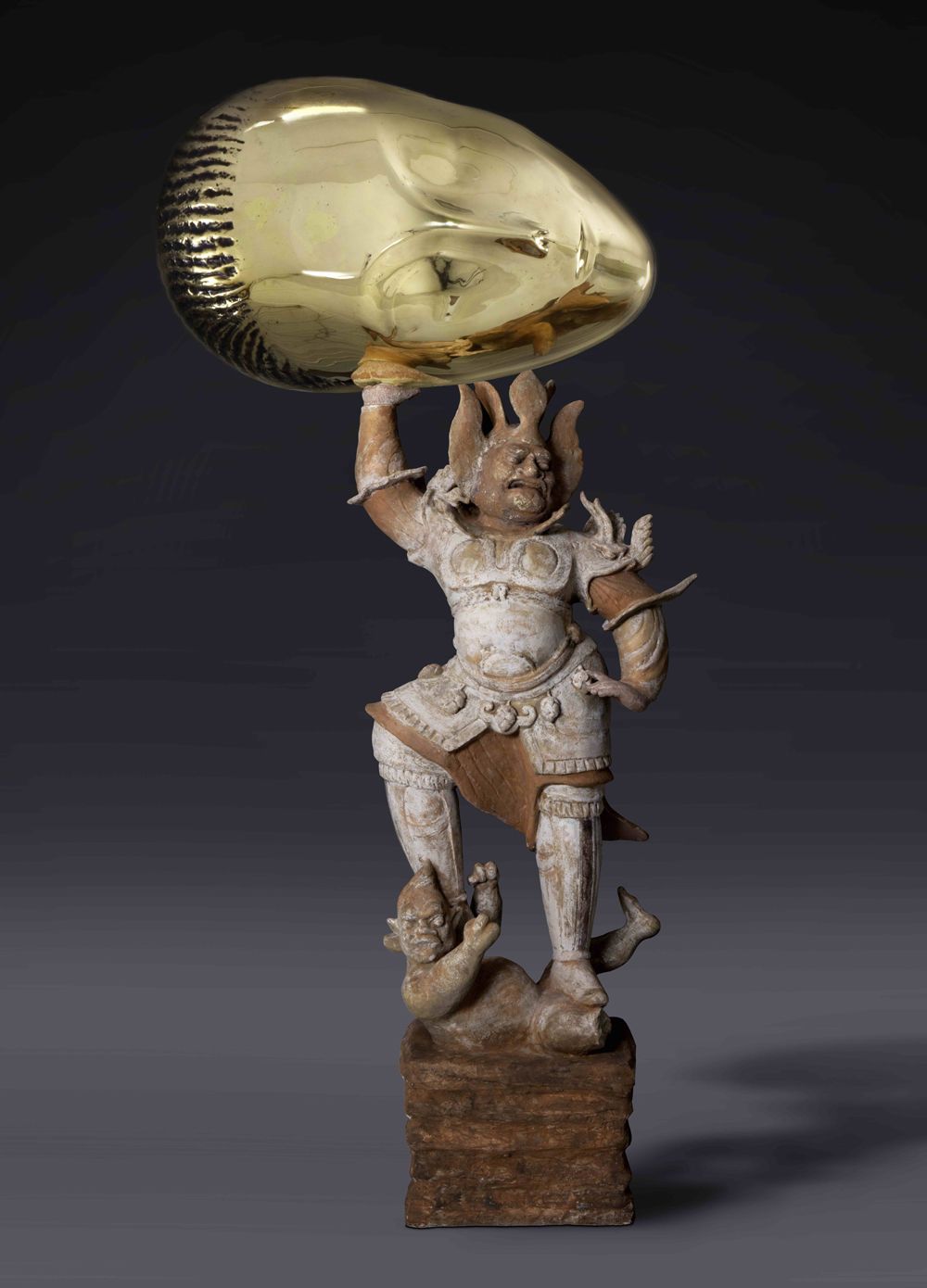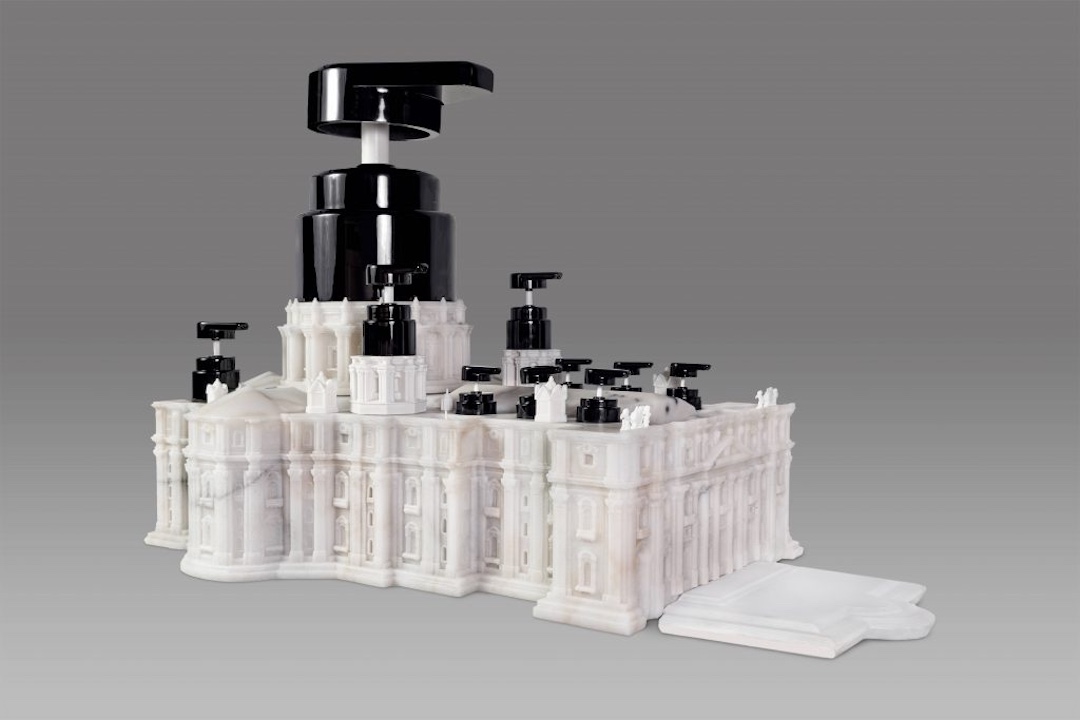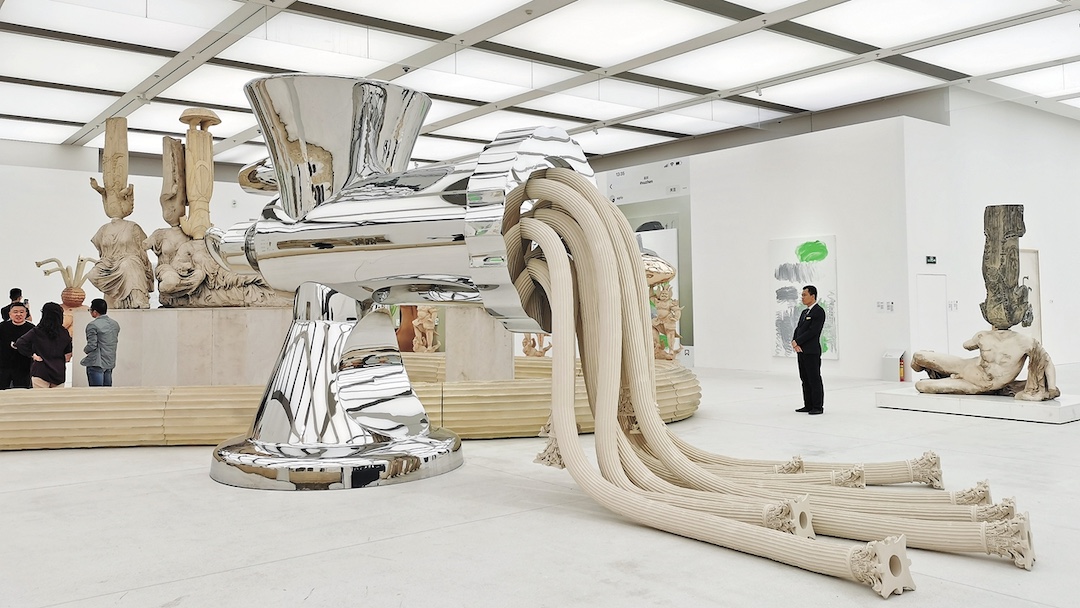Born in Shanghai, China, in 1977, Xu Zhen is an internationally known artist whose work is well-known in the East. He is an installation artist, photographer, painter, and performer. His work critiques the social and political conventions of both the East and the West. Xu’s works exhibit a sense of humor, sometimes black, and always inspire viewers to think about their meaning and application to current issues.
Xu received his art education at the Shanghai Arts and Crafts Institute. He was the youngest Chinese artist to show work at the prestigious Venice Biennale in 2001. His video, created in 1998, was titled “Rainbow.” In the video, a hand repeatedly slapped a man’s back until it became red. At the Venice Biennale of 2005, he presented the video “Shouting,” also made in 1998. He explained, “This work was made at a time when people were not so individualistic. What fascinated me as an artist then was the relationship between the individual and society. The act of shouting in a crowd of strangers is a way of showing my own existence. I wanted to create a moment that said, ‘I’m here!’”

“ShangArt Supermarket” (2007)
Xu created “ShangArt Supermarket” (2007) for Art Basel in Miami. The installation was an entire supermarket with products familiar to both Chinese and American consumers. All the packages, created in detail including prices, were empty. Viewers were fascinated and were eager to purchase the empty containers. He set up the supermarket in China with the same results: his empty boxes were eagerly purchased and are now displayed in various locations.
In 2000, Xu founded the non-profit art center Bizart. His team created exhibitions and events to bring more art to the public. In 2009, he established MadeIn, an art creation company. The company’s name was a play on the common commercial label “Made in China.” MadeIn introduced in 2013 the brand name Xu Zhen, making him a product of the company. The following year the MadeIn Gallery was opened to introduce and promote international contemporary artists and younger talent.

“Poseidon” (2014)
In 2014, Xu began the series Eternity. “Poseidon” (2014) (79’’x87’’x16’’), exhibited here on the beach at De Haan, Belgium, duplicates the classical bronze statue of Poseidon by Praxiteles (460 BCE) discovered at the bottom of the sea off Cape Artemision in Greece. The original bronze statue is 81” tall. When exhibited outdoors, the statue’s outstretched arms became resting places for pigeons. The birds are not pigeons; they are painted Peking ducks. Peking Duck is a popular dish in America and China. Special preparation includes inflating the duck skin for roasting, the result a crispy skin and tender meat.

“European Thousand Arms Classical Sculpture” (2015)
“European Thousand Arms Classical Sculpture” (2015) (10’x48’x15’) also is part of the Eternity series. It is composed of reproductions of famous Greek sculptures lined up behind the Goddess Athena. She wears a Greek warrior helmet since she is the Goddess of War. Her necklace is made of the snakes cut from Medusa’s head, and beside her is a large snake, mouth open, ready to strike. Behind her, lines of statues of Apollo, Zeus, Poseidon, Hercules, and other Greek heroes, many with their arms extended.
This work was influenced by the most popular Chinese Mahayana Buddhist figure of the Thousand-Hand Guanyin. She is a bodhisattva, one who delays entering Nirvana to remain on Earth in order to help others. Her thousand hands have eyes in their palms, representing her ability to see suffering and identify each person’s need. She is the bodhisattva of Compassion. The thousand arms of the classical figures are positioned in the manner of images of the Thousand-Hand Guanyin. East meets West, but the European lack of understanding of Chinese Buddhism, may lead to misunderstanding. For example, much of the male Greek sculpture may be interpreted as a massive fighting army to do great harm, not to fight evil and misery as Guanyin does. Xu hopes to promote understanding.

“Heavenly Guardian, Sleeping Muse” (2016)
In “Heavenly Guardian, Sleeping Muse” (2016) (93’’x40’’x24’’), another image from the Eternity series, Xu combines a Chinese Tang Tomb Guardian figure from the 8th Century with the 20th Century sculpture “Sleeping Muse” (1910) by Brancusi. Tomb Guardians were powerful and ferocious looking. They were intended to frighten and defeat evil spirits who wanted to disturb the dead.
The Tang figure is made of terracotta, as are many of the originals, and it is larger than most original tomb figures. Brancusi’s original “Muse” is cast bronze (6.5”x11”x8”). Xu’s is considerably larger and is raised high into the air by the tomb guardian. The combination of the figures represents the contrast between power and peace. The use of clay and bronze, represents a contrast between in the value of the materials. The “Sleeping Muse” is passive and meditative. The Tang figure is about force and protection. They initially do not seem to belong together, but they form a unique whole that inspires thought.
Xu’s explanation makes sense: “When I play with cultural elements, they don’t carry the same weight as they do for others. It’s not a lack of respect but I feel I can be audacious with such forms because I have a greater distance from them.”

“Hello” (2018-19)
“Hello” (2018-19) (stainless steel, Styrofoam, polyurethane, silicone, paint, and a robotic mechanism) is a toppled Corinthian column like those found in many Greek and Roman temples. Xu has not broken the shaft into pieces; they remain connected and curl around like the body of a snake. Snakes play a significant role in Greek mythology. They are symbols of knowledge, healing, and connection between the Earth and the underworld. The column’s capital, with its wide mouth, is mechanically engineered to follow the viewer. Surprise! Xu explains, “Here, I’ve used a traditional thing and renewed it in some way. It also has a threatening aspect, like the imperial civilizations in the Greek tradition, of a power system over you, a bit like a shadow. It’s interesting because, in the West, such columns would be used in official buildings such as courthouses and banks, whereas they most often appear in front of public baths in China, or places where you can sing karaoke.”

“Hello” (2022)
“Hello” has been in several exhibitions. Stanford University commissioned in 2022 a fifteen-foot bronze piece for the inaugural exhibition of the Stanford Plinth Project, a new sculpture garden, located in Meyer Green, a 2.45-acre open space. “Hello” sits on a plinth among tall cedar trees, greeting visitors.

“Alien I” (2017)
“Alien I” (2017) (31’x28’x47’) is composed of 28 kneeling figures in a wire caged prison setting. The pose of the figures in derived from Eastern Han Dynasty kneeling servant figures dating from c. 206 CE. The color of the robes immediately suggests today’s orange prison uniforms. The black head gear makes the figures anonymous and calls to mind the black head coverings worn by prisoners in detention centers. The viewer is in some way the prison guard. Xu mentions the constant media coverage of such images today, and the desensitization of people about oppression.

“St Peter’s Basilica” (2023)
Xu began in 2023 a series of sculptures he called Tools. Using modern day commonly used commercial items, he created sculptures. “St. Peter’s Basilica” (71”x71”x41″) is one of several significant Catholic churches depicted in the series. Filled hand sanitizer bottles replace the domes of St Peter’s. Viewers are encouraged to use the hand sanitizer. Xu combines the great items of history and art with one of the most commonly used products today.

“Roman Columns and Meat Grinder” (2024)
In “Roman Columns and Meat Grinder” (2024) (35’x16’x12’) Xu uses once again a Roman Corinthian column, symbolic as the stabilizer of Western culture. Romans assimilated the knowledge of Greek philosophy, literature, and art into their system of law and administration, creating the core of Western culture. This time the column is put through a meat grinder which instead of mincing it into little pieces, produces multiple columns.
In 2019 an interviewer asked Xu the question: “Many of your works walk a line between humor and darkness, between hope and threat. What draws you to this way of making?” Xu responded, “Perhaps it’s related to my own temperament. When I create a work, I’m always trying to find some kind of contradiction. I don’t like it to be completely white or black. When people look at my works, they sometimes try to find the black part or the white part. Through that, there’s a kind of democratic aspect, a kind of balance you can find in it. After creating work for twenty years, I wonder if it might also be related to the Chinese tradition of the yin and yang. While my work might appear direct, when you really try to understand it, I hope the meaning becomes a bit more blurry in the end.”
NOTE: Xu’s sculptures are composed of a variety of materials depending on the need. Among them are glass fiber, reinforced concrete, marble grains, limestone, chalk, artificial stone, sandstone grains, steel, and mineral pigments. The process includes scanning the original sculptures, working with 3D software, printing parts, and hand molding and casting.
Beverly Hall Smith was a professor of art history for 40 years. Since retiring to Chestertown with her husband Kurt in 2014, she has taught art history classes at WC-ALL and the Institute of Adult Learning, Centreville. An artist, she sometimes exhibits work at River Arts. She also paints sets for the Garfield Theater in Chestertown.



Write a Letter to the Editor on this Article
We encourage readers to offer their point of view on this article by submitting the following form. Editing is sometimes necessary and is done at the discretion of the editorial staff.